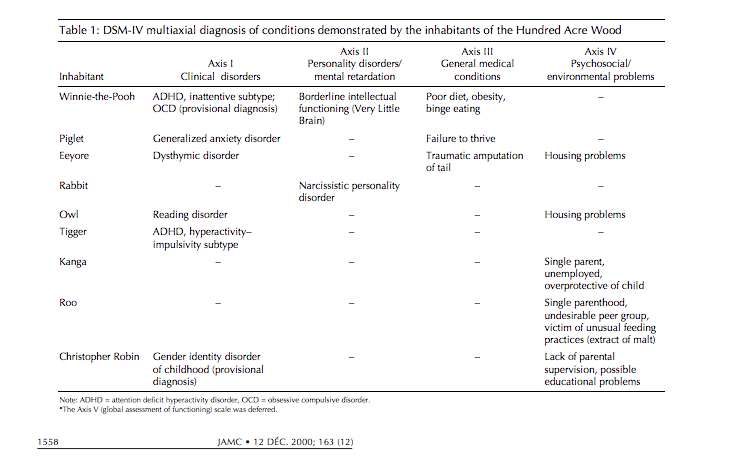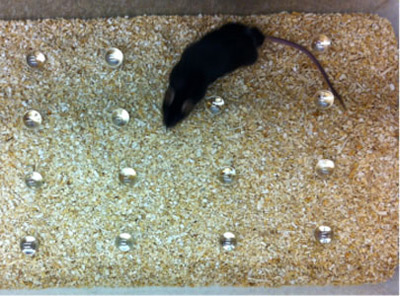Beloved childhood friends for many – A. A. Milne’s characters from the Hundred Acre Woods also presented models for various psychological disorders – anxiety (Piglet), obsessive-compulsive disorder (Rabbit), depression (Eeyore), ADHD (Tigger).
In fact, there is a full body of scientific research examining the various disorders represented by each character, such as a study conducted by Shea and colleagues (2000). As seen in the table below, these researchers analyzed each of the main characters in Winnie the Pooh stories for evidence of psychological disorders.

Using the criteria established by the Diagnostic and Statistical Manual of Mental Disorders – IV (DSM-IV), Shea and colleagues identified a number of criteria that satisfied diagnoses for several disorders including anxiety, obsessive compulsive disorder, ADHD, and depression. (Please note that the most current DSM edition (V) identifies gender identity disorder as gender dysphoria.)
Children do not generally view these characters as having problems, but rather as individuals with different characteristics who work together to solve different problems.
Whether one identifies with Tigger, Eeyore, Piglet, Rabbit, or Winnie the Pooh, these characters and their stories help to destigmatize psychological disorders, a critical issue in today’s society.
As a professor at an institution of higher learning, my peers and I are seeing more and more students experiencing acute and chronic psychological distress. This trend is consistent across many other institutions according to a recent post by the National Alliance on Mental Health (NAMI) Texas chapter. Whether there are more students presenting psychological distress, or whether this trend reflects greater awareness and acceptance of seeking mental health services, the result is the same – a dramatic increases in the use of university mental health centers.
According to the Anxiety and Depression Association of America, the most common psychological disorder is anxiety. About 18% of the U.S. adult population is walking around with some form of clinical anxiety every day and only a little over a 1/3 of them are receiving treatment. Globally, anxiety is estimated to affect 1 out of 13 individuals according to the World Health Organization (WHO). Women tend to be affected by different types of anxiety more than men, with one exception― obsessive compulsive disorder (OCD), which affects women and men equally and is prevalent in about 1% of the U.S. population.
Do animal models work?
As one of the most responsive psychological disorders to treatment, anxiety can be addressed through a variety of approaches, such as psychotropic drugs, cognitive-behavioral therapy, biofeedback, and others. Psychotropic drugs contribute to a billion dollar drug industry, which relies heavily on animal models during early drug development. Despite the controversy surrounding animal research, human testing of drug effectiveness is the last step in the drug development process, and animal models are considered necessary to this process.
Rodents are one type of animal model used to investigate many different psychological and neuropsychiatric conditions. Rodent models for narcolepsy, depression, obesity, anxiety, schizophrenia, to name a few, are critical for evaluating the efficacy of different types of drugs.
These models are versatile because they can withstand genetic alteration to investigate the myriad interactions between genetic makeup and drug actions. Rodent models, along with other animal models, are criticized for being too simplistic and artificial due to the types of tests given to simulate certain aspects of a targeted condition (e.g., can compulsive behavior like marble burying in rats simulate human compulsions?).
A recent article published in the Psychonomic Society’s journal Cognitive, Affective, and Behavioral Neuroscience addressed some of the issues associated with one of these rodent models.
Researchers Geoffrey de Brouwer, Arina Fick, Brian Harvey, and De Wet Wolmarans focused on a particular paradigm that creates artificial test conditions to simulate anxiety and OCD in rodents. In their review, de Brouwer and colleagues discussed the use of marble-burying behavior as a preclinical screening paradigm for assessing drug actions that target anxious and compulsive behaviors.
The first major problem identified in the review was the lack of consistency in all things methodological, which likely led to the second major problem—namely the chaos of inconsistent, incompatible, and unexpected results across more than 100 references investigating various drug actions on targeted mechanisms and receptors (e.g., reuptake of SSRIs inhibitors vs GABA antagonists vs genetic alteration vs sex hormones). All of these studies used some variation of the marble-burying paradigm as a proxy for anxious or compulsive behavior.
Variability should be good for science – Right?
The researchers argued that any animal model paradigm used to investigate a phenomenon must have standardized methods that have face validity, construct validity, and predictive validity if the paradigm is going to have any translational value. Thus, a paradigm methodology must make sense in the behavior it is testing, actually test the phenomenon of interest, and be able to predict the behavior in different contexts. De Brouwer and colleagues provided evidence that marble-burying did not meet these criteria across the majority of the studies.
Historically, marble-burying is considered a valid behavioral manifestation of several different neuropsychological constructs, including general anxiety and OCD. The paradigm requires that marbles (size not standardized) of some varying number (not standardized) be spread around a test area of varying size (again, not standardized), using some type of marble placement configuration (i.e., specific area, random, around the perimeter, yep, not standardized).
The measure of interest is how many marbles are buried (operational definition not standardized and performed by humans who may or may not be blind to the condition) by a subject after some period of time, up to 30 minutes (and once again, not standardized).
Given all of these variations, the research is then confounded more by whether or not the animals are habituated to the new environment to reduce the effects of neophobia (sometimes yes and sometimes no). And as De Brouwer and colleagues pointed out, there is no acknowledgment of whether a drug alters the animal’s locomotor activity and if so, how (not standardized, of course). Moreover, the influence of the sex, species, strain, and genetic makeup of the subjects being tested, are. . .yep, you guessed it, not standardized.

With this many variables varying from study to study, no wonder the current corpus is filled with incongruencies. Pooh, Piglet, and Rabbit would simply be overwhelmed with all of the possibilities, should this be one of the problems they must face in their adventures in the Hundred Acre Woods. My experimental warning bells are ringing and perhaps Christopher Robin stays home that day.
How to control the chaos. . .
While variability is useful for generalizability, the lack of reliability (both in methodological procedures and results) poses significant problems for the face validity, construct validity, and predictive validity of marble-burying as a proxy for anxious and compulsive behavior. De Brouwer and colleagues emphasized the importance of standardizing at least some of the variables that likely influence the behavior manifested while under the influence of some specific drug.
At the top of the researchers’ list of recommended actions: (1) using a fixed size of marble, (2) a fixed number of marbles, (3) a fixed marble configuration, all of which are standardized in a way that is species-appropriate (i.e., natural history and ecological validity are considered). For example, mice are smaller than rats and should have smaller marbles and arenas to work in compared to rats.
De Brouwer and colleagues also emphasized the importance of using dense substrate materials (with specific information identified in all studies). Denser material is less susceptible to marbles settling due to typical movements around the arena during investigation. This investigative behavior is normal for rodents and suggests that test subjects should have an opportunity to explore the test arena with testing substrate, such that neophobias can be controlled if not of interest to the primary research question.
By creating a more standardized testing environment, human coders (at least two) who are blind to the conditions for marble-burying should have an easier time producing reliable results, which could be verified by video tracking (strongly recommended by De Brouwer and colleagues).
Out of chaos comes order
Only after all of these procedures are standardized could the marble-burying paradigm possibly be a good model of anxious or compulsive behaviors. De Brouwer and colleagues’s comprehensive review of the current findings utilizing the marble-burying paradigm clearly indicated that this science has a long way to go before data can begin to form a cohesive body of scientific understanding. Perhaps if researchers work together like A.A. Milne’s characters of the Hundred Acres Woods, then the body of literature will exhibit less inconsistency and more modest variability.
Psychonomics article focused on in this post:
De Brouwer, G., Fick, A., Harvey, B. H., & (2019). A critical inquiry into marble-burying as a preclinical screening paradigm of relevance for anxiety and obsessive–compulsive disorder: Mapping the way forward. Cognitive, Affective, & Behavioral Neuroscience, 19, 1-39. 10.3758/s13415-018-00653-4.
